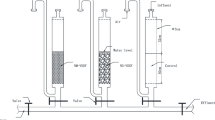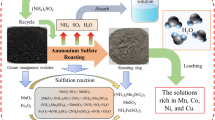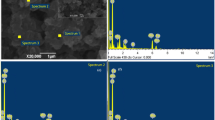Abstract
Deep ocean manganese nodules are significant futuristic resource of copper, nickel and cobalt. After recovery of these valuable metals, a huge quantity of residue (~70 % of ore body) is generated. In the present paper, investigations carried out for the application of washed manganese nodule leaching residue (wMNR) for the removal of nickel (Ni) ions from aqueous solution by adsorption are described. Several parameters have been varied to study the feasibility of using wMNR as potential adsorbent for remediation of Ni(II)-contaminated water. The adsorption kinetics followed pseudo-first-order equation, and the rate of adsorption increased with solution temperature. Kinetics data of Ni(II) adsorption were also discussed using diffusion models of Webber–Morris and Dumwald–Wagner models. The equilibrium data were best fitted into Langmuir adsorption isotherm, and the maximum adsorption capacity was found to be 15.15 mg g−1 at pH 5.5 and temperature 303 K, which decreased to 10.64 mg g−1 upon raising the solution temperature to 323 K. The activation energy for Ni(II) adsorption onto wMNR was 9.56 kJ mol−1 indicated physical sorption. Desorption studies showed successful regeneration of adsorbent and recovery of Ni. This process can be utilized for removal and recovery of Ni from the industrial effluent.





Similar content being viewed by others
References
Acharya S, Ghosh MK, Anand S, Das RP (1999) Leaching of metals from Indian Ocean nodules in SO2–H2O–H2SO4–(NH4)2SO4 medium. Hydrometallurgy 53:169–175
Argun ME, Dursun S, Gur K, Ozdemir C, Karatas M, Dogan S (2010) Ni adsorption on the modified pine tree materials. J Enviorn Technol 26:479–488
ATSDR (2005) Toxicological profile for nickel (update): chapter 6-potential exposure to human. Agency for Toxic Substances and Disease Registry (ASTDR) U.S. Department of Public Health and Human Services. http://www.atsdr.cdc.gov/ToxProfiles/tp15-c6.pdf. Accessed on 30.01.2013
Bayat B (2002) Comparative study of adsorption properties of Turkish fly ashes I. The case of nickel(II), copper(II) and zinc(II). J Hazard Mater B95:251–273
Boujelben N, Bouzid J, Elouear Z (2009) Adsorption process of Ni and Cu onto natural iron oxide coated sand from aqueous solution: study in single and binary system. J Hazard Mater 163:376–382
Cempel M, Nikel G (2006) Nickel: a review of its sources and environmental toxicology. Polish J Environ Stud 15:375–382
Das NN, Jana RK (2006) Adsorption of some bivalent heavy metal ions from aqueous solutions by manganese nodule leached residues. J Colloid Interface Sci 293:253–262
Green-Pederson H, Jensen BT, Pind N (1997) Ni adsorption on MnO2, Fe(OH)3, montmorillonite, humic acid and calcite: a comparative study. J Environ Technol 18:807–815
Hasar H (2003) Adsorption of nickel (II) from aqueous solution onto activated carbon prepared from almond husk. J Hazard Mater B97:49–57
Hema S, Kumuran TM, Sudha PN (2011) Adsorption of Cu and Ni ions on chitin/polyvinyl alcohol binary blend, kinetics & equilibrium studies. Inter J Environ Sci 2:624–637
Ho YS (2004) Citation review of Lagergren kinetic rate equation on adsorption reactions. Scientometrics 59:171–177
Ho YS (2006) Review of second-order models for adsorption systems. J Hazard Mater 136:103–111
Ho YS, McKay G (1998) A comparison of chemisorption kinetic models applied to pollutant removal on various sorbents. Proc Safety Environ Prot 76:332–340
Hussein AI, Mamdouh FA, Raouf AO (1998) Adsorption of nickel and mercury from drinking water stimulant by activated carbon. Environ Manage Health 9:170–175
INSA (2011) Hazardous metals and minerals pollution in India: Sources, Toxicity and management. Indian National Science Academy (INSA), Angkor Publishers (P) Ltd., Noida. http://insaindia.org/pdf/Hazardous_Metals.pdf. Accessed on 30.01.2013
Jadia CD, Fulekar MH (2009) Phytoremediation of heavy metals: recent techniques. Afr J Biotech 8:921–928
Jana RK, Pandey BD, Premchand (1999a) Ammoniacal leaching of roast reduced deep-sea manganese nodules. Hydrometallurgy 53:45–56
Jana RK, Srikanth S, Pandey BD, Kumar V, Premchand (1999b) Processing of deep sea manganese nodule at NML for recovery of copper, nickel and cobalt. Met Mater Proc 11:133–139
Lagergren S (1898) About the theory of so-called adsorption of soluble substances. Kungliga Svenska Vetenskapsa-kademiens. Handlingar 24:1–38
Lee GF (1974) Role of hydrous metal oxides in the transport of heavy metals in the environment. In: Proceedings of symposium of transport of heavy metals in the environment, vol 17, pp 137–147
Meng FW (2005) MS dissertation, Nanjing University, China
Moodley K, Singh R, Musapatika TE, Maurice OS, Ochieng A (2011) Removal of nickel from waste water using an agricultural adsorbent. Water SA 37:41–47
Nicolaidou A, Nott JA (1990) Mediterranean pollution from a ferro-nickel smelter. Mar Poll Bullet 21:137–143
Parida KM, Mallick S, Mohapatra BK, Misra VN (2004) Studies on manganese-nodule leached residues; 1. Physicochemical characterization and its adsorption behavior toward Ni2+ in aqueous system. J Colloid Interface Sci 277:48–54
Paul DJ, Mermoz S, Emmanuel D, Pascalin K, Daniel N (2012) Surface modification of magnetite rich clay with eriochrome black T. application for adsorption of Ni in aqueous solution. J Appl Surf Sci 258:7470–7479
Sprynskyy M, Buszewski B, Terzyk AP, Namiesnik J (2006) Study of the selection mechanism of heavy metal (Pb2+, Cu2+, Ni2+, and Cd2+) adsorption on clinoptilolite. J Colloid Interface Sci 304:21–28
Srivastava VC, Mall ID, Mishra IM (2006) Characterization of mesoporous rice husk ash (RHA) and adsorption kinetics of metal ions from aqueous solution onto RHA. J Hazard Mater 134:257–267
Suryan S, Ahluwalia SS (2012) Biosorption of heavy metals by paper mill waste from aqueous solution. Inter J Environ Sci 2:1331–1343
Vogel AI (1978) A text book of quantitative inorganic analysis, 4th edn. Longmans, London
Wang S, Ming HT, Slo MT (2008) Effects of manufacturing condition on the adsorption capacity of heavy metal ions by making bamboo charcoal. Bioresour Technol 99:7027–7033
WHO (2008) Guidelines for drinking-water quality-third edition. WHO Press, World Health Organization. http://www.who.int/water_sanitation_health/dwq/fulltext.pdf. Accessed on 30.01.2013
Zheng W, Zhang LS, Jing QZ (2009) Adsorption of nickel ion by zeolite-attapulgite composite nano-size adsorbent. In: Proceedings of the 3rd international conference on bioinformatics and biomedical engineering (ICBBE-2009), Nanjing, China, pp 1–4
Acknowledgments
The authors wish to thank the Director, CSIR-NML, Jamshedpur, for his permission to publish this paper.
Author information
Authors and Affiliations
Corresponding author
Rights and permissions
About this article
Cite this article
Randhawa, N.S., Dwivedi, D., Prajapati, S. et al. Application of manganese nodules leaching residue for adsorption of nickel(II) ions from aqueous solution. Int. J. Environ. Sci. Technol. 12, 857–864 (2015). https://doi.org/10.1007/s13762-013-0460-4
Received:
Revised:
Accepted:
Published:
Issue Date:
DOI: https://doi.org/10.1007/s13762-013-0460-4




